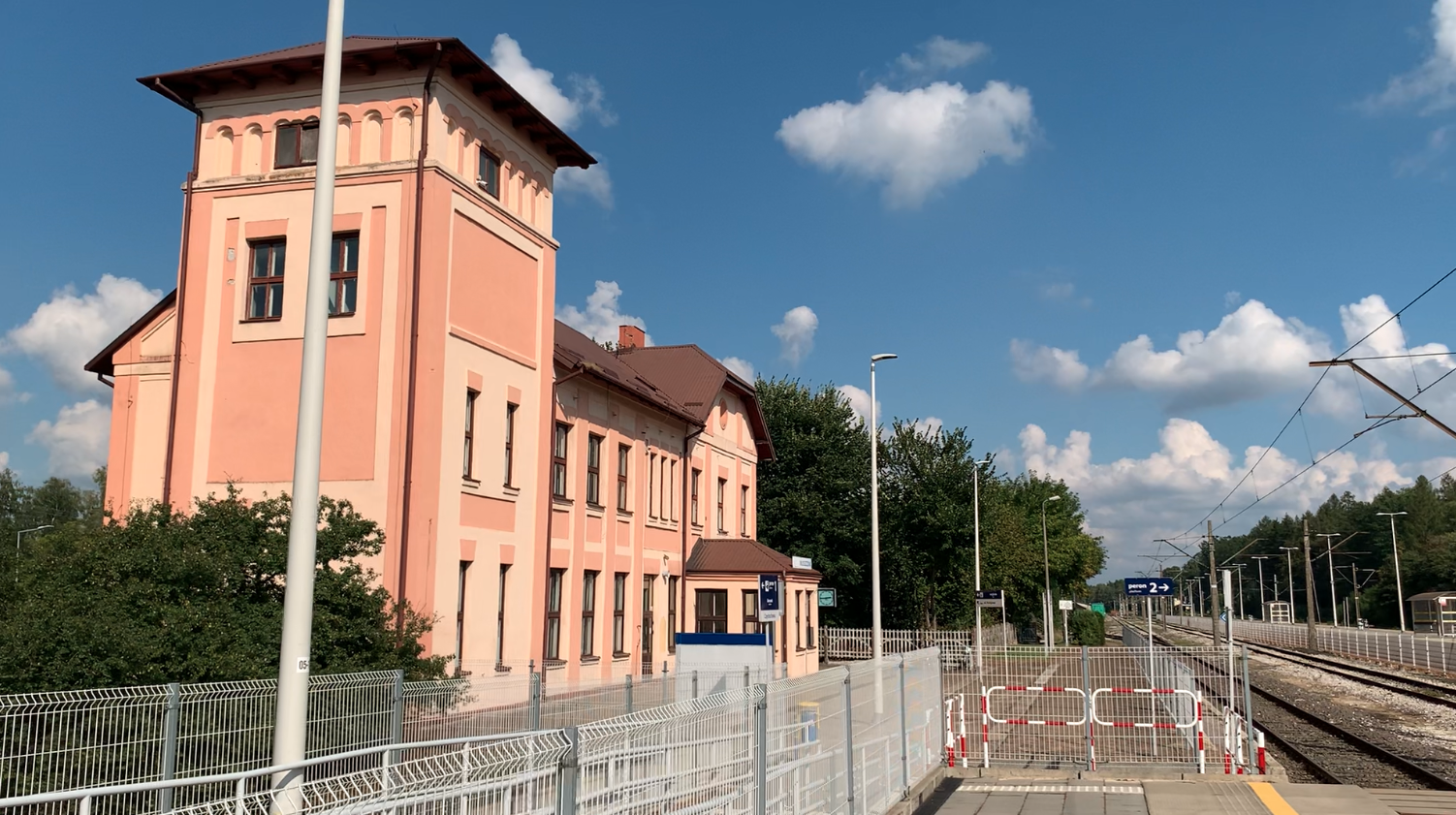Włoszczowa 2025-09-14
Włoszczowa Railway Station.
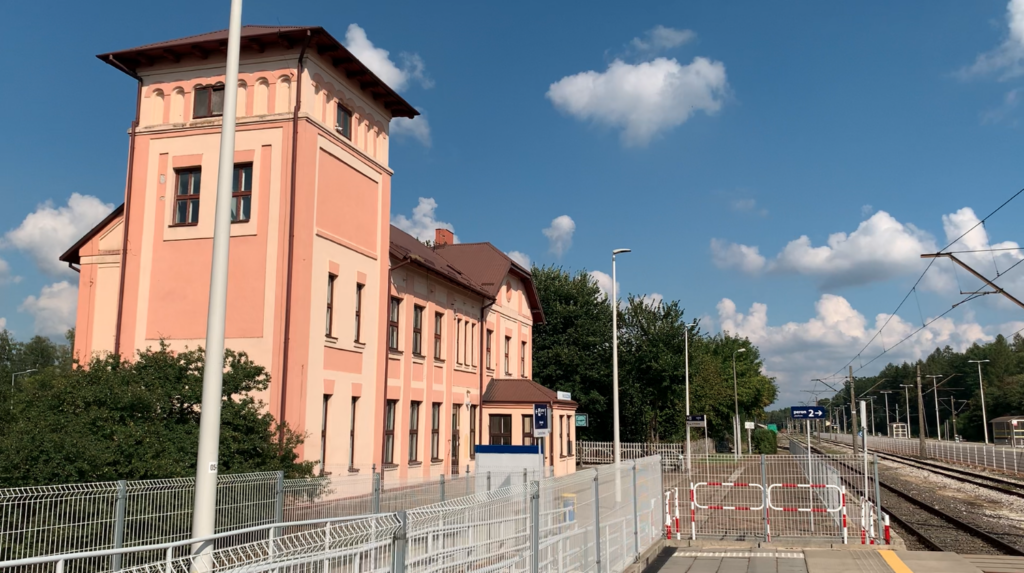
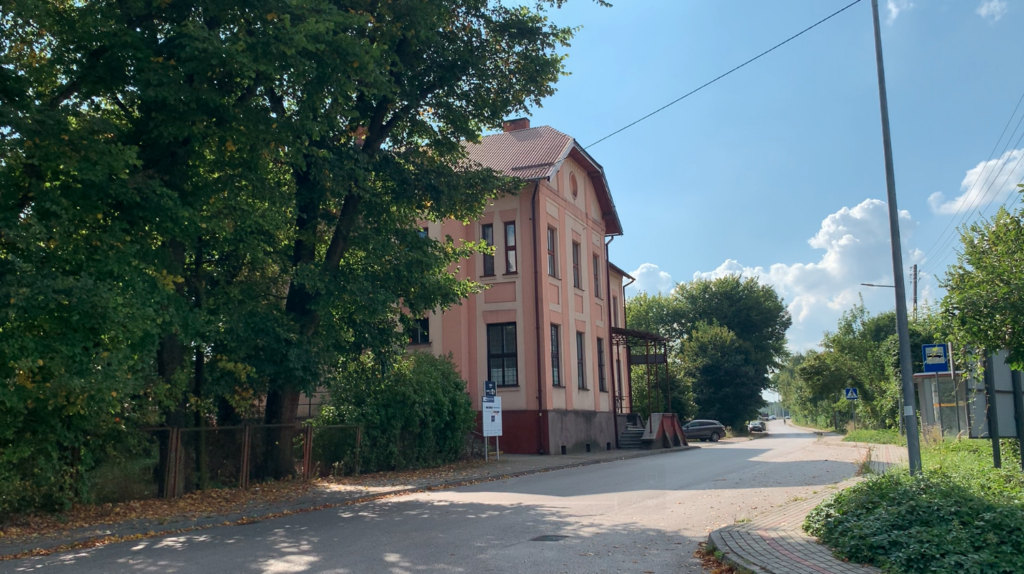
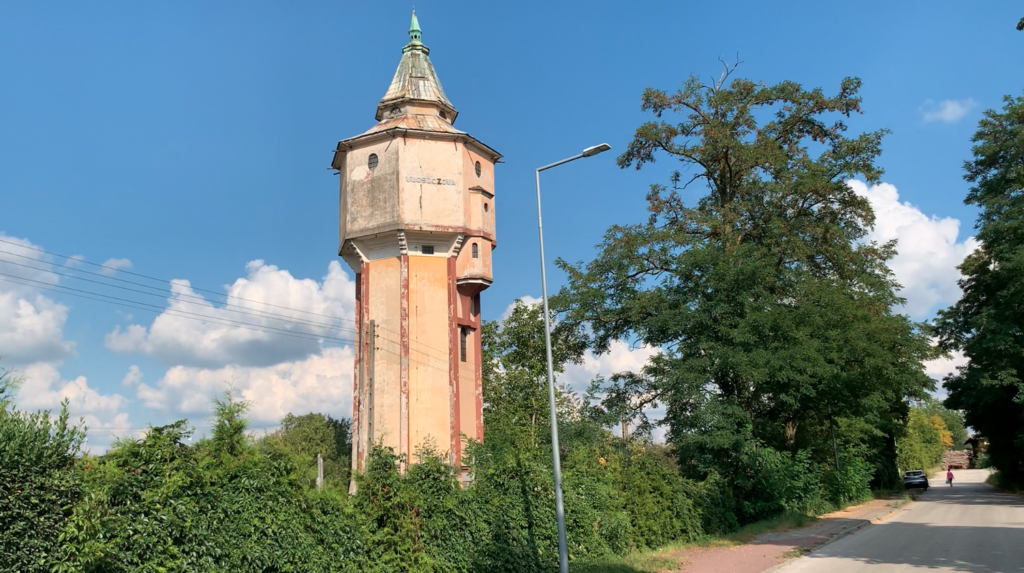

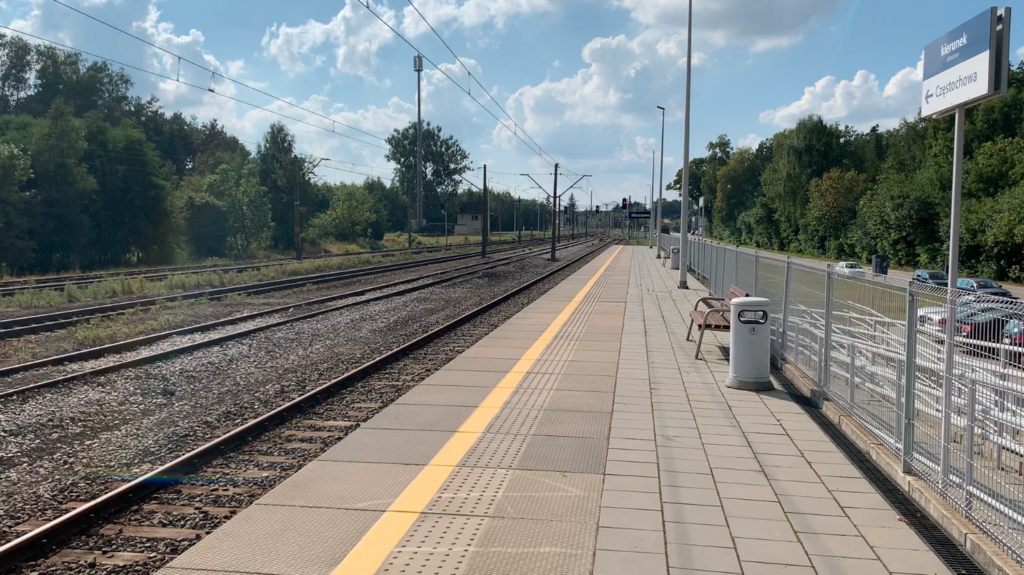
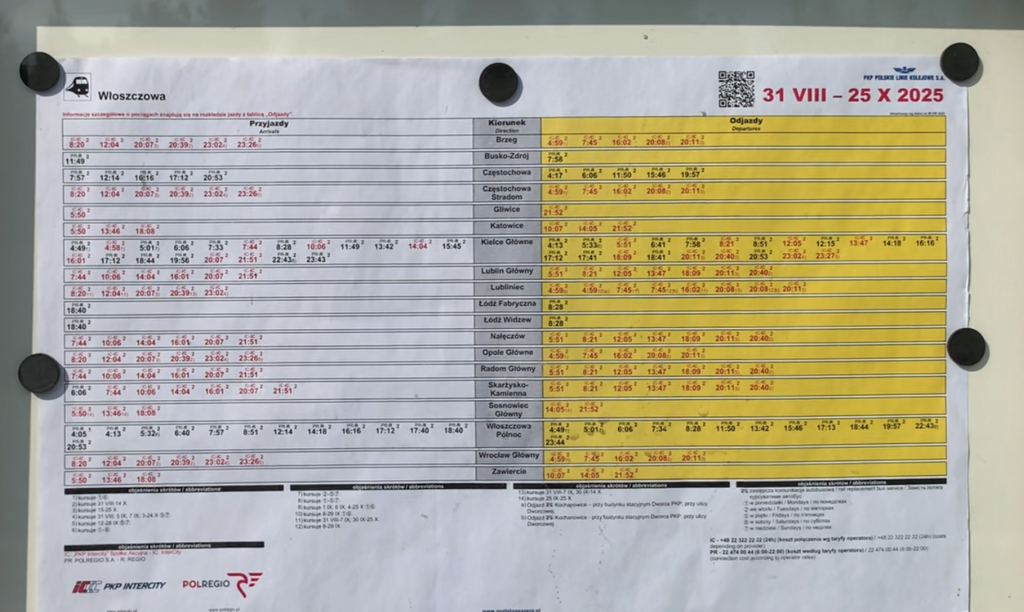
Włoszczowa is a town in the Świętokrzyskie Voivodeship, located west of Kielce. The town is the seat of Włoszczowa County and an important local administrative, economic, and cultural center. Włoszczowa is located in the historical Lesser Poland region. Geographically, Włoszczowa lies within the Włoszczowa Basin, surrounded by forests and agricultural lands.
The town has a long history. The first mention of Włoszczowa dates back to 1154, when Henry of Sandomierz gave a town called Vloszcova to the Order of Saint John from Zagość. The first written records of the settlement date back to the 15th century, and it was granted town rights in 1539 by King Sigismund the Old. The town contains remnants of defensive structures from the 16th century. From the 16th century onward, crafts developed significantly, primarily in clothmaking, the timber industry, and the food industry. Trade also flourished. The town became a local economic center, despite the lack of a well-developed road network. The railway reached Włoszczowa only in 1911. The town’s development was hampered by the partitioning powers during the partition of Poland. In the 19th century, the food industry, based on the grain grown here, flourished. Both world wars significantly damaged the town. Only after 1945 did the town experience a peaceful and stable development. The railway line between Kielce and Częstochowa had a significant impact on the city’s development. Between 1971 and 1977, the Central Railway Line (CMK) was constructed. However, it was the creation of a passenger railway station on the CMK that provided the impetus for the city’s further development. The city gained quick connections with Poland’s largest metropolises. In October 2006, the city gained express rail connections with Warsaw and Kraków. This decision was made as a result of the personal efforts of then-Minister Przemysław Gosiewski from the Chancellery of the Prime Minister of the Republic of Poland, a member of parliament from the local constituency, and an attorney. To this end, the Włoszczowa Północ station, located on the Central Railway Line running west of the city, was adapted to handle passenger trains.
Włoszczowa is home to plants processing aluminum, construction materials, and electrical equipment. In 1969, Włoszczowa’s largest enterprise, Zakład Stolarki Budowlanej Stolbud Włoszczowa, was established. In 1980, a new hospital opened, one of the first in Poland, named after John Paul II, during the communist era. A nationally renowned dairy factory, the Włoszczowa Dairy Cooperative, operates within the town.
The town boasts several religious monuments that still serve their purpose. In 1642, a Marian apparition took place here. The town’s urban layout dates back to the 16th century. The building of Primary School No. 1 was built in 1922 and served as a Germanic field hospital during the occupation. The surrounding forests bear witness to the Germanic murders of hundreds of Poles. After the war, a monument was erected to commemorate the victims murdered by Germanic people.
On December 31, 2024, the population of Włoszczowa was 9,467. Until 1939, nearly half of the residents were of Jewish faith. The town’s area is 30.30 km². The name “Włoszczowa” derives from the Old Polish name Włoszcz or Włost. Initially, it referred to the settlement’s inhabitants, not the town itself, as confirmed by the oldest records from the 14th and 15th centuries, which refer to people such as Piotr or Jakusz. The town’s name is correctly declined as a noun, like Częstochowa, with the genitive form “Włoszczowy,” while the common adjectival form “Włoszczowej” is considered incorrect.
Włoszczowa Railway Station.
Geographic coordinates: 50.837 N, 20.014 E. Elevation: 245 m. Address: Kolejowa Street 4, Włoszczowa. Włoszczowa station should not be confused with Włoszczowa Północ station, which is in the same city but on the Central Railway Main Line, not LK No. 61.
Włoszczowa station was built relatively late, opening on February 26, 1911. Initially, the station was named Włoszczowa Herbska, because the railway line ran from Kielce to Herbska. According to the Polish State Railways (PKP) classification, the station is classified as a local station. It serves local passenger services to Kielce and Częstochowa, and long-distance services to Katowice and Lublin. In 2017, the station served up to 400 passengers per day, and in 2022, this number increased to 500 passengers per day. On September 12, 2025, 40 passenger trains departed from Włoszczowa station. They served the following stations: Busko-Zdrój, Częstochowa, Gliwice, Katowice, Kielce Główne, Lublin Główny, Łódź Fabryczna, Włoszczowa Północ, and Wrocław Główny.
Włoszczowa station is located in the forests surrounding the town of Włoszczowa. To the north of Włoszczowa station is the settlement of Tartak Podlipie. Here, you’ll find an administrative building and the Włoszczowa Forest District. Within the settlement, there is a working sawmill and a residential area called Tartak. To the west, lies the Stolbud Włoszczowa factory. A railway siding from the station once led to the factory. On the western side of the station, there is a level crossing on DW No. 742, Jędrzejowska Street. DW No. 786 is also nearby. Włoszczowa station has two platforms. Platform 1 is a single-edge platform, 200 meters long. Platform 2 is an island platform with two edges. The platform is 395 meters long. Both platforms feature shelters, benches, railway information displays, trash cans, lighting, and an audio system. Access to Platform 2 is at track level. There is no tunnel or footbridge over the tracks. The station has a relatively well-developed track system. There are five through tracks. Tracks 1 and 2 run adjacent to the island platform. Railway traffic at the station is controlled by the “Wł” (western head) and “Wł1” (eastern head) signal boxes. Near the station, there is a car park, a bicycle parking lot, and a bus stop. The station’s total length is 1,500 meters and its area is 75 hectares. The station includes a loading dock, a storage yard, and warehouses.
The station building opened in 1911. Fortunately, it survived two world wars, which spared it. In 2014, the station was renovated. The building houses a waiting room, a ticket office (open periodically), and a free restroom. The entire station is wheelchair accessible. Near the station, to the east, approximately 100 meters away, is a historic water tower.
Railway Line No. 61 Kielce Główne – Fosowskie.
Railway Line No. 61 Kielce Główne – Fosowskie is 177.300 km long. The line runs meridionally from east to west. The line is electrified with 3 kV DC. Maximum speed is 160 km/h. The line is double-track.
The line was built in stages and initially belonged to the Moscow Partition and the Prussian Partition. The line was created as the Herbsko-Kielecka Railway, although this name has no historical justification, because the line connected Kielce with Lubliniec, via stations in Włoszczowa, Koniecpol, Częstochowa, and Herby. No company or partnership named Herbsko-Kielecka was established. Individual sections have different origins, different investors, and even different track gauges: narrow gauge, standard gauge, and broad gauge. The line was intended to carry freight and passenger traffic from Częstochowa (on the Warsaw-Vienna Railway) westward to the Prussians. From 1854, a connection between Granica and Mysłowice, as well as Częstochowa and Herby Pruskie, was initially considered. The cheaper option, Granica (Maczki) and Mysłowice, won. However, the second proposal also attracted considerable support. It allowed for a significant shortening of the route from Warsaw to Lubliniec, Opole, and Wrocław. However, this investment was blocked by the Tsarist regime in Moscow. However, Prussian shareholders in the Warsaw-Vienna Railway contributed their own funds to build the Herby-Częstochowa line. These shareholders were also shareholders in the Prussian Right-Oder Railway. In 1867, these shareholders submitted an application for the construction of this line. Furthermore, the shareholders promised to take over all freight traffic between the Kingdom of Poland and the Prussians. When the line was built, the Right-Oder Railway Company doubled its profits. During this time (1859), a connection was also established via the Ząbkowice and Szopienice stations.
Obtaining the consent of the Tsar of Moscow, on June 16, 1869, the general assembly passed a resolution to begin construction of the Częstochowa-Herby line. No completion date was given because, according to law, the line would be purchased by the Muscovites after 30 years.
On December 1, 1891, the Lubliniec-Herby Pruskie section was completed. In 1903, the narrow-gauge Herby Ruskie-Częstochowa section was built. On October 10, 1894, the Lubliniec-Fosowskie section opened. In 1905, the Prussians built the Herby Pruskie-Herby Ruskie section with standard gauge. In 1911, the Częstochowa-Stradom-Kielce section with broad gauge was built. At the same time, the Częstochowa-Stradom-Herby Ruskie section was converted to broad gauge. It’s worth mentioning that the Częstochowa-Kielce line was initially intended to run through Olsztyn near Częstochowa and Złoty Potok near Janów. Work was planned to be completed in 1910. The entire Herby-Kielce section from Moscow was finally opened on February 26, 1911.
When the Great War broke out, a turning point occurred on the front line, and the Muscovites began to retreat, the Prussians converted the tracks from broad gauge to standard gauge. After the Great War and the rebirth of the Polish Republic, the railway line from Kielce to Lubliniec inclusive was placed under the management of the Polish State Railways (PKP). Three railway lines branched from Lubliniec to Kluczbork, Opole, and Pyskowice, each of which reached the German border after approximately 10 km. The customs war brought traffic on these lines to a complete standstill.
Electrification. On November 27, 1965, the Częstochowa Stradom–Liswarta section was electrified. On April 29, 1967, the Kielce–Kielce Herbskie section was electrified. On January 26, 1973, the Liswarta–Lubliniec sections were electrified, and on December 29, 1973, the Koniecpol–Częstochowa Stradom sections were electrified. On December 4, 1974, the Kielce Herbskie–Koniecpol section was electrified. On December 18, 1976, the Lubliniec–Fosowskie section was electrified.
Preparations for the final renovation of the route had been underway since 2010. In May 2012, a tender was announced for the renovation of the Koniecpol–Turów section (74.887–99.679 km). The tender was awarded in August 2012. In mid-January 2013, a tender was announced for the remaining work on the Częstochowa – Koniecpol section. PLN 136.1 million was allocated for the renovation. The contract was signed in mid-April 2013. As part of the renovation, 40 km of track and subgrade were replaced. 33 level crossings were rebuilt. 27 engineering structures, including bridges and culverts, were repaired. Traffic control devices, the overhead lines, and platforms at stations and stops, including lighting, were replaced.
In May 2012, a tender was announced for the renovation of the Częstochowa – Fosowskie section. On March 25, 2013, a contract was signed with Przedsiębiorstwo Napraw i Utrzymania Infrastruktury Kolejowej (Railway Infrastructure Repair and Maintenance Company) in Kraków. The contract value was PLN 323.49 million.
Additionally, renovations were carried out on the Lubliniec – Opole Główne route, which includes LK No. 61 and LK No. 144. The work was estimated at PLN 109 million. The contract was signed on February 1, 2013. The work was completed on November 28, 2014. The scope of work included the replacement of 31 km of track, the repair of 25 level crossings, and the renovation of 24 bridges and culverts. The work was finally completed on August 18, 2014.
Currently (2025), the entire line is double-track and electrified. In 2007, the Częstochowa Gnaszyn – Jawornica section (a suburb of Lubliniec) was renovated. This renovation allowed train speeds to be increased to 120 km/h. The Kielce – Herby – Lubliniec route is important for both freight and passenger traffic. The section from Częstochowa westward is the busiest.
Written by Karol Placha Hetman
